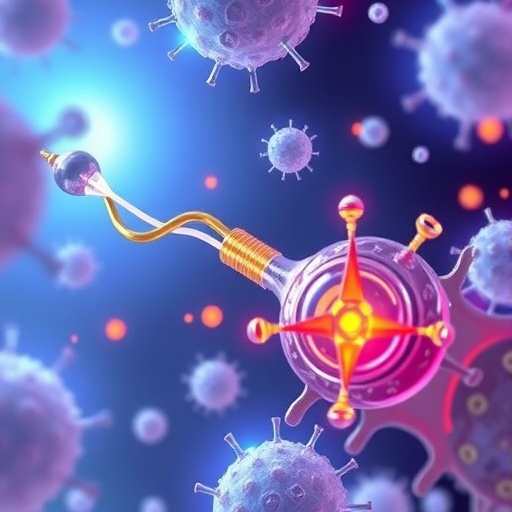In a groundbreaking advancement poised to revolutionize our understanding of oncogenic condensates, researchers have unveiled a novel “killswitch” micropeptide capable of disrupting cancer-driving protein assemblies in acute myeloid leukemia (AML). This pivotal study harnesses cutting-edge genetic engineering and live-cell imaging to deeply probe the resilience and vulnerabilities of fusion oncoprotein condensates, illuminating fresh avenues for targeted therapeutics in aggressive malignancies. The intricate interplay between the NUP98::KDM5A fusion protein and its condensate microenvironment—long elusive due to technical challenges—has now been deciphered with remarkable clarity, setting a new paradigm in cancer cell biology.
The team leveraged a sophisticated mouse model of AML, wherein hematopoietic stem and progenitor cells (HPSCs), derived from fetal liver tissue, undergo malignant transformation upon expression of the NUP98::KDM5A fusion oncoprotein. Subsequent transplantation into recipient mice allows for the in vivo expansion of leukemic cells showcasing disease-relevant condensate formation. By introducing doxycycline-inducible constructs encoding a GFP-tagged nanobody-based killswitch (GFP-nb–KS), researchers were able to effectuate conditional modulation of NUP98::KDM5A condensates within a stable AML cell line that carries an N-terminal GFP tag on the fusion protein itself.
Crucially, the presence of this inducible killswitch robustly arrested the proliferation of AML cells, as demonstrated by growth curve analysis of mCherry-sorted populations. In contrast, a mutant variant of the killswitch harboring phenylalanine-to-alanine substitutions (KS_F-to-A) failed to impede cell proliferation, underscoring the specificity of the molecular intervention. Complementary competition assays corroborated these findings, emphasizing the killswitch’s potent inhibitory capacity on cancer cell viability dependent on NUP98::KDM5A-driven condensates.
Further mechanistic insights were gleaned by genetically fusing the killswitch directly to GFP–NUP98::KDM5A, which severely compromised the transformation potential of primary fetal liver-derived HPSCs. This fusion construct significantly diminished the cells’ replating efficiency, altered their immunophenotypic landscape, and downregulated key target genes driven by the oncogenic fusion. Taken together, these experiments convincingly demonstrate that the killswitch is sufficient not only to inhibit leukemic cell growth but also to disrupt fundamental oncogenic programs orchestrated by fusion condensates.
Fluorescence microscopy provided a visually striking window into the immediate cellular consequences following killswitch expression. Upon doxycycline induction and subsequent mCherry reporter activation, NUP98::KDM5A condensates rapidly dissipated both in number and intensity, coinciding with a marked reduction of fusion oncoprotein levels. The KS_F-to-A mutant variant, in stark contrast, exhibited no appreciable effect on condensate persistence or protein abundance, further reinforcing the functional dependence on precise killswitch structure.
An unexpected and illuminating discovery emerged when proteasome inhibitors were applied for brief durations in killswitch-expressing cells. Partial restoration of NUP98::KDM5A protein abundance occurred, but instead of reverting to typical condensate morphology, the fusion protein aggregated into large, amorphous structures. This observation reveals that the proteasome actively mediates degradation of perturbed fusion oncoproteins, and that cells deploying the killswitch likely trigger a surveillance pathway recognizing misassembled condensates as substrates for clearance.
The researchers confronted technical barriers in directly assessing the biophysical material properties of NUP98::KDM5A condensates within AML cells, as low endogenous expression levels thwarted fluorescence recovery after photobleaching (FRAP). To circumvent this limitation, they transiently transfected HEK293T cells with both the fusion protein and killswitch constructs. Here, FRAP assays definitively confirmed that the killswitch arrested the internal dynamics of NUP98::KDM5A condensates, effectively “freezing” their normally liquid-like behavior. This arrest of molecular mobility within condensates offers a mechanistic framework for how the killswitch impairs oncogenic function.
These findings imply that NUP98::KDM5A condensate dynamics are not merely epiphenomenal but integral to leukemogenic proliferation. By stalling these dynamics, the killswitch enacts a multipronged attack: it disrupts condensate assembly, curtails fusion protein stability through proteasomal degradation, and ultimately throttles cancer cell growth. The rapid and robust antiproliferative effect observed signals extraordinary potential for therapeutic exploitation, especially given the traditionally “undruggable” nature of fusion oncoproteins forming phase-separated compartments.
Beyond revealing vulnerabilities, this study spotlights the fragility of cancer cells’ reliance on fusion protein condensates for survival. The inability of leukemic cells to tolerate perturbations induced by the killswitch underscores the delicately poised balance oncogenic condensates maintain. Targeting the biophysical underpinnings of these structures, therefore, emerges as a promising strategy to overcome resistance and achieve durable clinical outcomes.
The implication of proteasome-dependent degradation pathways in response to condensate perturbation also broadens the conceptual landscape of fusion oncoprotein turnover. It suggests that induced condensate disruption could synergize with proteostasis modulators to enhance selective clearance of oncogenic drivers. This interplay between phase separation disruption and protein degradation introduces new dimensions to drug combination strategies.
As cancer biology increasingly embraces the significance of biomolecular condensates, tools like the described micropeptide killswitch furnish unparalleled means to dissect condensate microenvironments with precision. This approach transcends classical pharmacology, incorporating biophysical manipulation and synthetic biology. The translational potential is vast, with generalizable implications for a spectrum of malignancies harboring fusion oncoproteins.
In sum, this visionary work not only sheds light on the fundamental biology of NUP98::KDM5A condensates in AML but also forges a novel therapeutic path. By cleverly engineering a conditionally expressed micropeptide capable of arresting condensate dynamics and provoking subsequent degradation, researchers have dismantled a hitherto invincible oncogenic fortress. The journey from model system validation to molecular mechanistic understanding paves the way to clinical innovation, heralding a new era of condensate-targeted cancer therapy.
Subject of Research: Cancer cell biology; molecular mechanisms of oncogenic condensates in acute myeloid leukemia (AML)
Article Title: Probing condensate microenvironments with a micropeptide killswitch
Article References:
Zhang, Y., Stöppelkamp, I., Fernandez-Pernas, P. et al. Probing condensate microenvironments with a micropeptide killswitch. Nature (2025). https://doi.org/10.1038/s41586-025-09141-5
Image Credits: AI Generated




